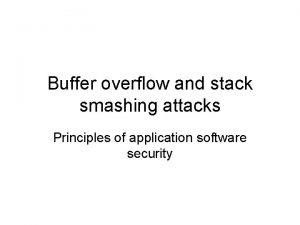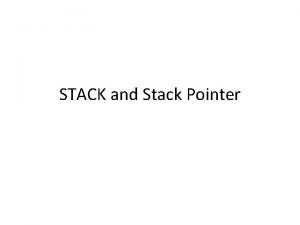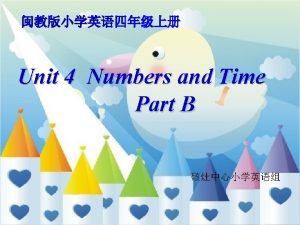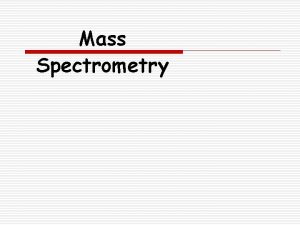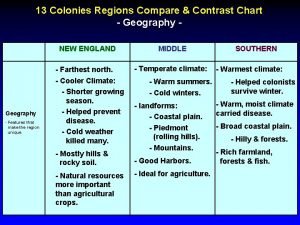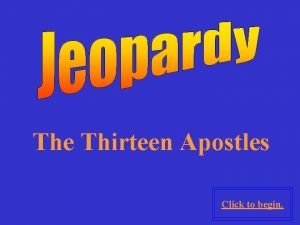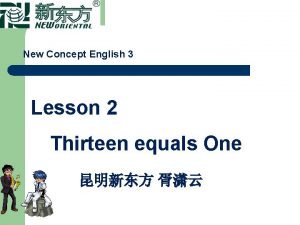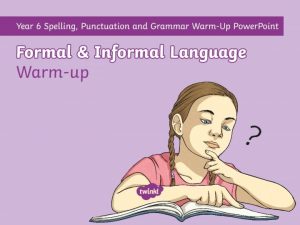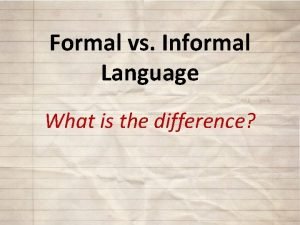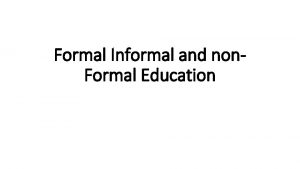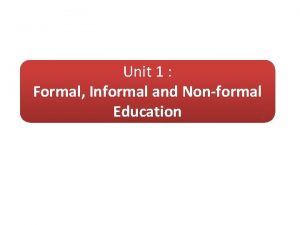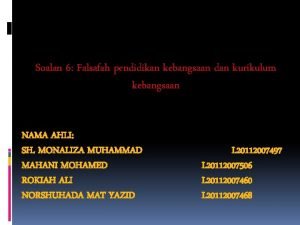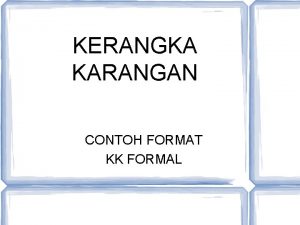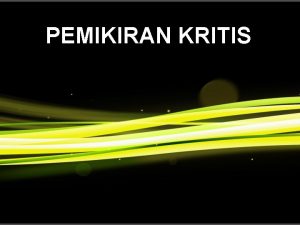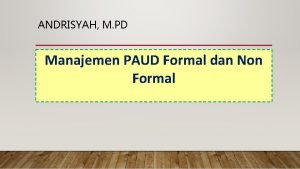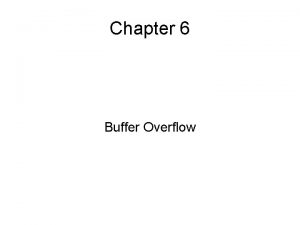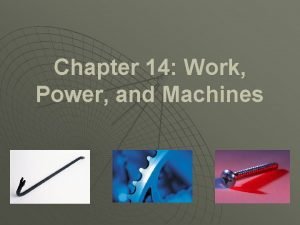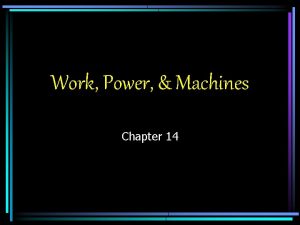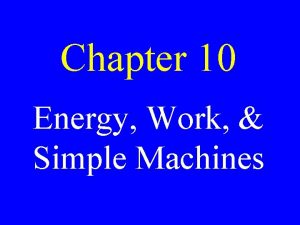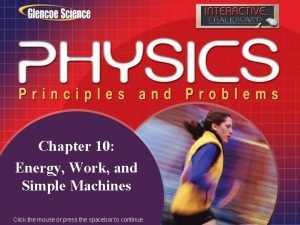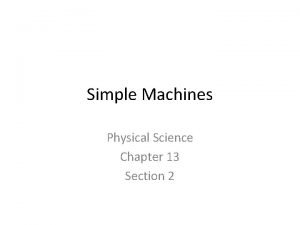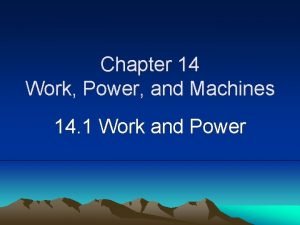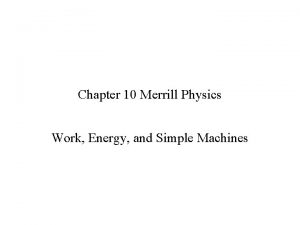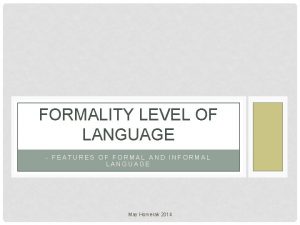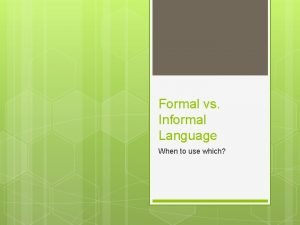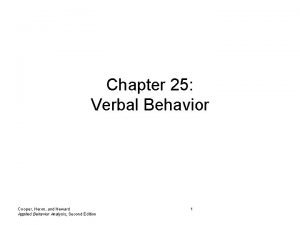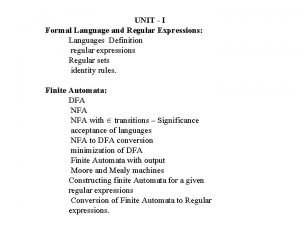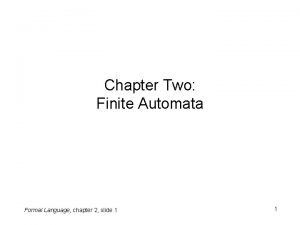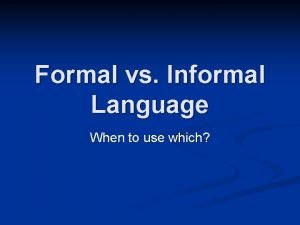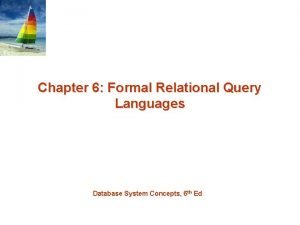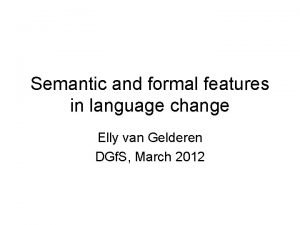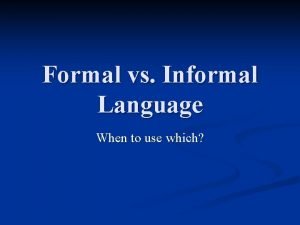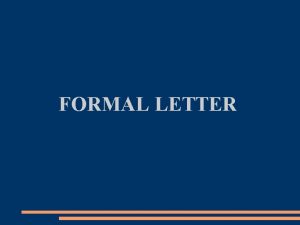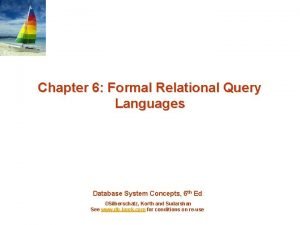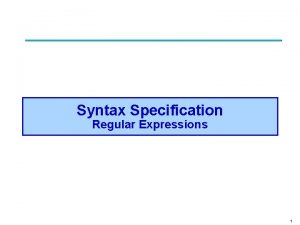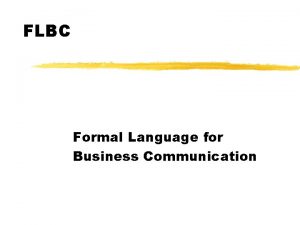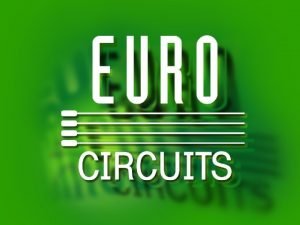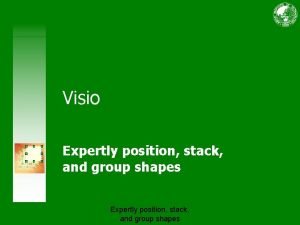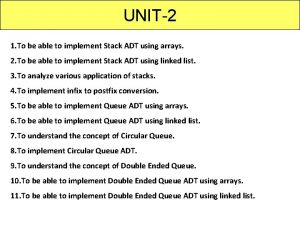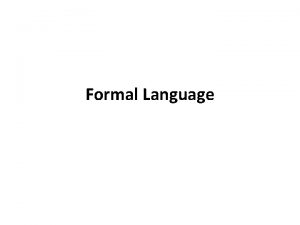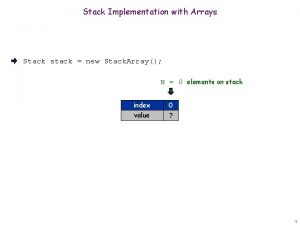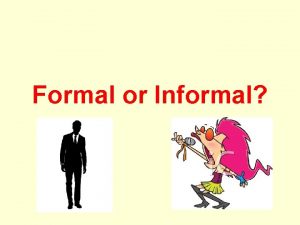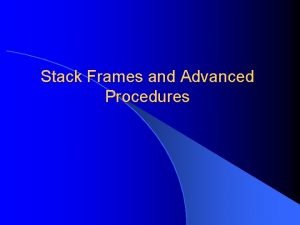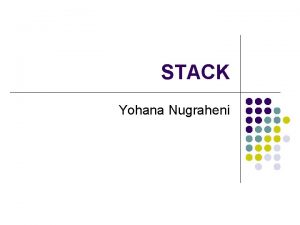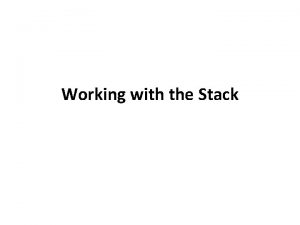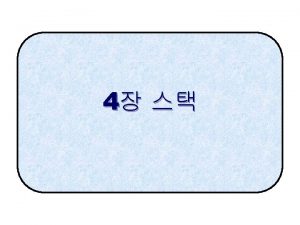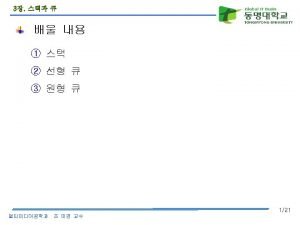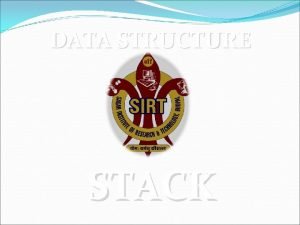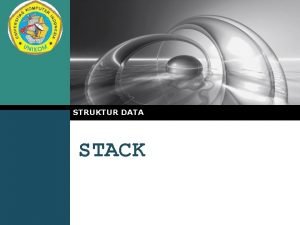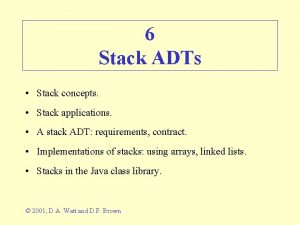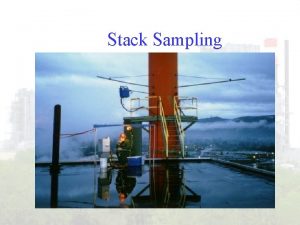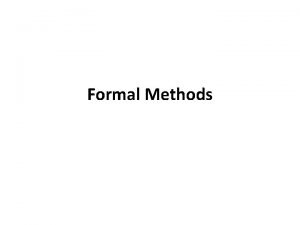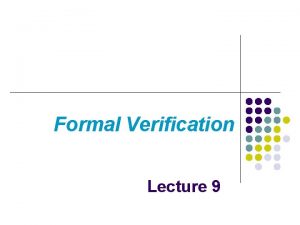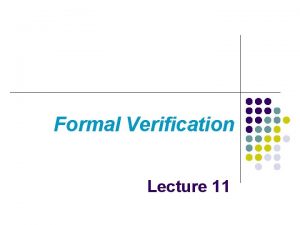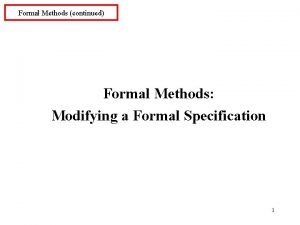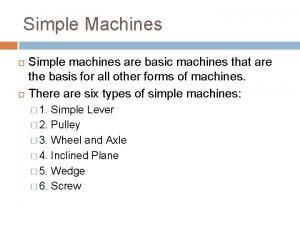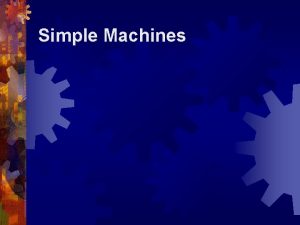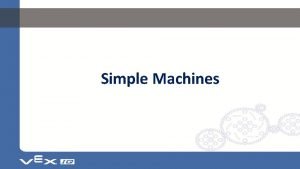Chapter Thirteen Stack Machines Formal Language chapter 13



























































- Slides: 59

Chapter Thirteen: Stack Machines Formal Language, chapter 13, slide 1 1

Stacks are ubiquitous in computer programming, and they have an important role in formal language as well. A stack machine is a kind of automaton that uses a stack for auxiliary data storage. The size of the stack is unbounded—it never runs out of space—and that gives stack machines an edge over finite automata. In effect, stack machines have infinite memory, though they must use it in stack order. If you travel by two paths that seem to depart in different directions, it is a surprise to discover that they lead to the same destination. It makes that destination feel more important—an intersection rather than a dead end. That is the situation with context-free languages. Stack machines and CFGs seem like two very different mechanisms for language definition—two paths that depart in different directions. But it turns out that these two paths lead to the same place. The set of languages that can be defined using 2 Formal Language, chapter 13, slide 2 a stack machine is exactly the same as the set of languages

Outline • • 13. 1 Stack Machine Basics 13. 2 A Stack Machine for {anbn} 13. 3 A Stack Machine for {xx. R} 13. 4 Stack Machines, Formally Defined 13. 5 Example: Equal Counts 13. 6 Example: A Regular Language 13. 7 A Stack Machine for Every CFG 13. 8 A CFG For Every Stack Machine Formal Language, chapter 13, slide 3 3

Stacks • A stack machine maintains an unbounded stack of symbols • We'll represent these stacks as strings • Left end of the string is the top of the stack – For example, abc is a stack with a on top and c on the bottom – Popping abc gives you the symbol a, leaving bc on the stack – Pushing b onto abc produces the stack babc Formal Language, chapter 13, slide 4 4

Stack Machine Moves • A stack machine is an automaton for defining languages, but unlike DFA and NFA: no states! • It is specified by a table that shows the moves it is allowed to make. For example: • Meaning: – If the current input symbol is a, and – if the symbol on top of the stack is c, it may make this move: – pop off the c, push abc, and advance to the next input symbol Formal Language, chapter 13, slide 5 5

Leaving The Stack Unchanged • Every move pops one symbol off, then pushes a string of zero or more symbols on • To specify a move that leaves the stack unchanged, you can explicitly push the popped symbol back on: • Meaning: – If the current input symbol is a, and – if the symbol on top of the stack is c, it may make this move: – pop off the c, push it back on, and advance to the next input symbol Formal Language, chapter 13, slide 6 6

Popping The Stack • Every move pushes a string onto the stack • To specify a move that pops but does not push, you can explicitly push the empty string: • Meaning: – If the current input symbol is a, and – if the symbol on top of the stack is c, it may make this move: – pop off the c, push nothing in its place, and advance to the next input symbol Formal Language, chapter 13, slide 7 7

Moves On No Input • The first column can be ε • Like a ε -transition in an NFA, this specifies a move that is made without reading an input symbol • Meaning: – Regardless of what the next input symbol (if any) is, – if the symbol on top of the stack is c, it may make this move: – pop off the c, and push ab in its place Formal Language, chapter 13, slide 8 8

Stack Machines • A stack machine starts with a stack that contains just one symbol, the start symbol S • On each move it can alter its stack, but only as we have seen: only in stack order • Like an NFA, a stack machine may be nondeterministic: it may have more than one sequence of legal moves on a given input • A string is in the language if there is at least one sequence of legal moves that reads the entire input string and ends with the stack empty Formal Language, chapter 13, slide 9 9

Example • Consider input a (and, as always, initial stack S): • Three possible sequences of moves – Move 1 first: no input is read and the stack becomes ab; then stuck, rejecting since input not finished and stack not empty – Move 2 first: a is read and the stack becomes ef; rejecting since stack not empty – Move 3 first: a is read and the stack becomes empty; accepting Formal Language, chapter 13, slide 10 10

Outline • • 13. 1 Stack Machine Basics 13. 2 A Stack Machine for {anbn} 13. 3 A Stack Machine for {xx. R} 13. 4 Stack Machines, Formally Defined 13. 5 Example: Equal Counts 13. 6 Example: A Regular Language 13. 7 A Stack Machine for Every CFG 13. 8 A CFG For Every Stack Machine Formal Language, chapter 13, slide 11 11

Strategy For {anbn} • • • We'll make a stack machine that defines the language {anbn} As always, the stack starts with S Reading the input string from left to right: 1. For each a you read, pop off the S, push a 1, then push the S back on top – In the middle of the string, pop off the S; at this point the stack contains just a list of zero or more 1 s, one for each a that was read – For each b you read, pop a 1 off the stack • This ends with all input read and the stack empty, if and only if the input was in {anbn} Formal Language, chapter 13, slide 12 12

Stack Machine For {anbn} • That strategy again: 1. For each a you read, pop off the S, push a 1, then push the S back on top 2. In the middle of the string, pop off the S; at this point the stack contains just a list of zero or more 1 s, one for each a that was read 3. For each b you read, pop a 1 off the stack Formal Language, chapter 13, slide 13 13

• Accepting aaabbb: – – – – Start: Move 1: Move 2: Move 3: input: aaabbb; stack: S 111 input: aaabbb; stack: 1 input: aaabbb_; stack empty Formal Language, chapter 13, slide 14 14

• A rejecting sequence for aaabbb: – – Start: input: aaabbb; stack: S Move 1: input: aaabbb; stack: S 1 Move 2: input: aaabbb; stack: 1 No legal move from here • But, as we've seen, there is an accepting sequence, so aaabbb is in the language defined by the stack machine Formal Language, chapter 13, slide 15 15

Outline • • 13. 1 Stack Machine Basics 13. 2 A Stack Machine for {anbn} 13. 3 A Stack Machine for {xx. R} 13. 4 Stack Machines, Formally Defined 13. 5 Example: Equal Counts 13. 6 Example: A Regular Language 13. 7 A Stack Machine for Every CFG 13. 8 A CFG For Every Stack Machine Formal Language, chapter 13, slide 16 16

Strategy For {xx. R} • • We'll make a stack machine for {xx. R | x ∈ {a, b}*} Reading the input string from left to right: 1. For each a you read, pop off the S, push a, then push the S back on top – For each b you read, pop off the S, push b, then push the S back on top 1. In the middle of the string, pop off the S; at this point the stack contains just a sequence of as and bs, the reverse of the input string read so far – For each a you read, pop a off the stack – For each b you read, pop b off the stack • This ends with all input read and the stack empty, if and only if the input was in {xx. R | x ∈ {a, b}*} Formal Language, chapter 13, slide 17 17

Stack Machine For {xx. R} • That strategy again: 1. For each a you read, pop off the S, push a, then push the S back on top 2. For each b you read, pop off the S, push b, then push the S back on top 3. In the middle of the string, pop off the S; at this point the stack contains just a sequence of as and bs, the reverse of the input string read so far 4. For each a you read, pop a off the stack 5. For each b you read, pop b off the stack Formal Language, chapter 13, slide 18 18

• Accepting abbbba: – – – – Start: Move 1: Move 2: Move 3: Move 5: Move 4: input: abbbba; stack: Sa input: abbbba; stack: Sbba input: abbbba; stack: a input: abbbba_; stack empty Formal Language, chapter 13, slide 19 19

Nondeterminism • This stack machine (like the previous) can pop the S off the top of the stack at any time • But there is only one correct time: it must be popped off in the middle of the input string • This uses the nondeterminism of stack machines • We can think of these machines as making a guess about where the middle of the input is • All the sequences with a wrong guess reject • But the one sequence that makes the right guess accepts, and one is all it takes Formal Language, chapter 13, slide 20 20

Outline • • 13. 1 Stack Machine Basics 13. 2 A Stack Machine for {anbn} 13. 3 A Stack Machine for {xx. R} 13. 4 Stack Machines, Formally Defined 13. 5 Example: Equal Counts 13. 6 Example: A Regular Language 13. 7 A Stack Machine for Every CFG 13. 8 A CFG For Every Stack Machine Formal Language, chapter 13, slide 21 21

The 4 -Tuple • A stack machine M is a 4 -tuple M = (Γ, Σ, S, δ ) – – Γ is the stack alphabet Σ is the input alphabet S ∈ Γ is the initial stack symbol δ ∈ ((Σ∪ {ε }) × Γ → P(Γ*) is the transition function • The stack alphabet and the input alphabet may or may not have symbols in common Formal Language, chapter 13, slide 22 22

Transition Function • Type is δ ∈ ((Σ∪ {ε }) × Γ → P(Γ*) • That is, in δ (x, y) = Z: – x is an input symbol or ε – y is a stack symbol – The result Z is a set of strings of stack symbols • The result is a set because the stack machine is nondeterministic • For a given input symbol x and top-of-stack symbol y, there may be more than one move • So, there may be more than one string that can be pushed onto the stack in place of y Formal Language, chapter 13, slide 23 23

Example • M = (Γ, Σ, S, δ ) where – Γ = {S, a, b, e, f} – Σ = {a} – δ (ε , S) = {ab} δ (a, S) = {ε , ef} Formal Language, chapter 13, slide 24 24

Instantaneous Descriptions • At any point in a stack machine's operation, its future depends on two things: – That part of the input string that is still to be read – The current contents of the stack • An instantaneous description (ID) for a stack machine is a pair (x, y) where: – x ∈Σ* is the unread part of the input – y ∈Γ* is the current stack contents • As always, the left end of the string y is considered to be the top of the stack Formal Language, chapter 13, slide 25 25

A One-Move Relation On IDs • We will write I ↦ J if I is an ID and J is ID that follows from I after one move of the stack machine • Technically: ↦ is a relation on IDs, defined by the δ function for the stack machine as follows: – Regular transitions: (ax, Bz) ↦ (x, yz) if and only if y ∈ δ (a, B) – ε -transitions: (x, Bz) ↦ (x, yz) if and only if y ∈ δ (ε , B). • Note no move is possible when stack is empty Formal Language, chapter 13, slide 26 26

Zero-Or-More-Move Relation • As we did with grammars and NFAs, we extend this to a zero-or-more-move ↦* • Technically, ↦* is a relation on IDs, with I ↦* J if and only if there is a sequence of zero or more relations that starts with I and ends with J • Note this is reflexive by definition: we always have I ↦* I by a sequence of zero moves Formal Language, chapter 13, slide 27 27

A Stack Machine's Language • The language accepted by a stack machine is the set of input strings for which there is at least one sequence of moves that ends with the whole string read and the stack empty • Technically, L(M) = {x ∈ Σ* | (x, S) ↦* (ε , ε )} Formal Language, chapter 13, slide 28 28

Previous Example • Accepting abbbba: – – – – Start: Move 1: Move 2: Move 3: Move 5: Move 4: input: abbbba; stack: Sa input: abbbba; stack: Sbba input: abbbba; stack: a input: abbbba_; stack empty Formal Language, chapter 13, slide 29 29

Example, Continued • M = ({a, b, S}, {a, b}, S, δ ), where – δ (a, S) = {Sa} δ (a, a) = {ε } δ (b, S) = {Sb} δ (b, b) = {ε } δ (ε , S) = {ε } • The accepting sequence of moves for abbbba is – (abbbba, S) ↦ (bbbba, Sa) ↦ (bbba, Sba) ↦ (bba, Sbba) ↦ (bba, bba) ↦ (ba, ba) ↦ (a, a) ↦ (ε , ε ) • (abbbba, S) ↦* (ε , ε ) and so abbbba ∈ L(M) Formal Language, chapter 13, slide 30 30

Considering L(M) • Only move 3 changes the number of S on the stack • So any accepting sequence uses 3 exactly once: (xy, S) ↦* (y, Sz) ↦ 3 (y, z) ↦* (ε , ε ) with moves 1 and 2 before 3, and 4 and 5 after • 1 and 2 push the symbol just read, so z = x. R • 4 and 5 pop symbols matching input, so z = y • So accepting sequences are all of this form: (xx. R, S) ↦* (x. R, Sx. R) ↦ 3 (x. R, x. R) ↦* (ε , ε ) • L(M) = {xx. R | x ∈ {a, b}*} Formal Language, chapter 13, slide 31 31

Outline • • 13. 1 Stack Machine Basics 13. 2 A Stack Machine for {anbn} 13. 3 A Stack Machine for {xx. R} 13. 4 Stack Machines, Formally Defined 13. 5 Example: Equal Counts 13. 6 Example: A Regular Language 13. 7 A Stack Machine for Every CFG 13. 8 A CFG For Every Stack Machine Formal Language, chapter 13, slide 32 32

A Language Of Equal Counts • Let A = {x ∈ {a, b}* | the number of as in x equals the number of bs in x} • Not the same as {anbn}, since abab ∈ A • A first attempt: – For each a, push a 0 – For each b, pop a 0 – Pop off the S (at the end) Formal Language, chapter 13, slide 33 33

First Attempt • • Moves 1 and 2 push a 0 for each a Move 3 pops a 0 for each b Move 4 pops the S, leaving the stack empty In any accepting sequence, move 4 comes last: – It's the only way to move the S – Once the stack is empty, no further moves are possible Formal Language, chapter 13, slide 34 34

First Attempt • M = ({0, S}, {a, b}, S, δ ), where – δ (a, S) = {0 S} δ (b, 0) = {ε } δ (a, 0) = {00} δ (ε , S) = {ε } • The accepting sequence of moves for abab is – (abab, S) ↦ (bab, 0 S) ↦ (ab, S) ↦ (b, 0 S) ↦ (ε , ε ) • (abab, S) ↦* (ε , ε ) and so abab ∈ L(M) Formal Language, chapter 13, slide 35 35

Problem • This works on some examples, but not all • Everything M accepts is in our target language A, but not everything in A is accepted by M • Consider abba: (abba, S) ↦ (bba, 0 S) ↦ (ba, S) ↦ ? • M has no way to accept strings like abba that have a prefix with more bs than as Formal Language, chapter 13, slide 36 36

Improved Strategy • When the number of as so far exceeds the number of bs, keep count with 0 s on the stack, as before • When the number of bs so far exceeds the number of as, keep count with 1 s instead • At the end, pop off the S Formal Language, chapter 13, slide 37 37

Solution • M = ({0, S}, {a, b}, S, δ ), where – δ (a, S) = {0 S} δ (b, 0) = {ε } δ (b, 1) = {11} δ (ε , S) = {ε } δ (a, 0) = {00} δ (b, S) = {1 S} δ (a, 1) = {ε } • The accepting sequence of moves for abba is – (abba, S) ↦ (bba, 0 S) ↦ (ba, S) ↦ (a, 1 S) ↦ (ε , ε ) • (abba, S) ↦* (ε , ε ) and so abba ∈ L(M) • This solution now has L(M) = A Formal Language, chapter 13, slide 38 38

Outline • • 13. 1 Stack Machine Basics 13. 2 A Stack Machine for {anbn} 13. 3 A Stack Machine for {xx. R} 13. 4 Stack Machines, Formally Defined 13. 5 Example: Equal Counts 13. 6 Example: A Regular Language 13. 7 A Stack Machine for Every CFG 13. 8 A CFG For Every Stack Machine Formal Language, chapter 13, slide 39 39

Simulating DFAs • A stack machine can easily simulate any DFA – – Use the same input alphabet Use the states as stack symbols Use the start state as the start symbol Use a transition function that keeps exactly one symbol on the stack: the DFA's current state – Allow accepting states to be popped; that way, if the DFA ends in an accepting state, the stack machine can end with an empty stack Formal Language, chapter 13, slide 40 40

Example • M = ({q 0, q 1, q 2, q 3}, {0, 1}, q 0, δ ) – – – δ (0, q 0) = {q 0} δ (0, q 1) = {q 2} δ (0, q 2) = {q 0} δ (0, q 3) = {q 2} δ (ε , q 2) = {ε } δ (1, q 0) = {q 1} δ (1, q 1) = {q 3} δ (1, q 2) = {q 1} δ (1, q 3) = {q 3} δ (ε , q 3) = {ε } • Accepting sequence for 0110: – (0110, q 0) ↦ (10, q 1) ↦ (0, q 3) ↦ (ε , q 2) ↦ (ε , ε ) Formal Language, chapter 13, slide 41 41

DFA To Stack Machine • Such a construction can be used to make a stack machine equivalent to any DFA • It can be done for NFAs too • It tells us that the languages definable using a stack machine include, at least, all the regular languages • In fact, regular languages are a snap: we have an unbounded stack we barely used • We won't give the construction formally, because we can do better… Formal Language, chapter 13, slide 42 42

Outline • • 13. 1 Stack Machine Basics 13. 2 A Stack Machine for {anbn} 13. 3 A Stack Machine for {xx. R} 13. 4 Stack Machines, Formally Defined 13. 5 Example: Equal Counts 13. 6 Example: A Regular Language 13. 7 A Stack Machine for Every CFG 13. 8 A CFG For Every Stack Machine Formal Language, chapter 13, slide 43 43

From CFG To Stack Machine • A CFG defines a string rewriting process • Start with S and rewrite repeatedly, following the rules of the grammar until fully terminal • We want a stack machine that accepts exactly those strings that could be generated by the given CFG • Our strategy for such a stack machine: – Do a derivation, with the string in the stack – Match the derived string against the input Formal Language, chapter 13, slide 44 44

Strategy • Two types of moves: 1. A move for each production X →y 2. A move for each terminal a ∈Σ • The first type lets it do any derivation • The second matches the derived string and the input • Their execution is interlaced: – type 1 when the top symbol is nonterminal – type 2 when the top symbol is terminal Formal Language, chapter 13, slide 45 45

Example: {xx. R | x ∈ {a, b}*} S → a. Sa | b. Sb | ε • Derivation for abbbba: S ⇒ a. Sb ⇒ ab. Sba ⇒ abb. Sbba ⇒ abbbba • Accepting sequence of moves on abbbba: (abbbba, S) ↦ 1 (abbbba, a. Sa) ↦ 4 (bbbba, Sa) ↦ 2 (bbbba, b. Sba) ↦ 5 (bbba, Sba) ↦ 2 (bbba, b. Sbba) ↦ 5 (bba, Sbba) ↦ 3 (bba, bba) ↦ 5 (ba, ba) ↦ 5 (a, a) ↦ 4 (ε , ε ) Formal Language, chapter 13, slide 46 46

Lemma 13. 7 If G = (V, Σ, S, P) is any context-free grammar, there is some stack machine M with L(M) = L(G). • Proof sketch: by construction • Construct M = (V∪Σ, Σ, S, δ ), where – for all v ∈V, δ (ε , v) = {x | (v→x) ∈P} – for all a ∈Σ, δ (a, a) = {ε } • M accepts x if and only if G generates x • L(M) = L(G) • (Missing: detailed proof that (x, S) ↦* (ε , ε ) if and only if S ⇒* x) Formal Language, chapter 13, slide 47 47

Summary • We can make a stack machine for every CFL • That's stronger than our demonstration in the last chapter of a stack machine for every regular language • So now we know that the stack machines are at least as powerful as CFGs for defining languages • Are they more powerful? Are there stack machines that define languages that are not CFLs? Formal Language, chapter 13, slide 48 48

Outline • • 13. 1 Stack Machine Basics 13. 2 A Stack Machine for {anbn} 13. 3 A Stack Machine for {xx. R} 13. 4 Stack Machines, Formally Defined 13. 5 Example: Equal Counts 13. 6 Example: A Regular Language 13. 7 A Stack Machine for Every CFG 13. 8 A CFG For Every Stack Machine Formal Language, chapter 13, slide 49 49

From Stack Machine To CFG • We can't just reverse the previous construction, since it produced restricted productions • But we can use a similar idea • The executions of the stack machine will be exactly simulated by derivations in the CFG • To do this, we'll construct a CFG with one production for each move of the stack machine Formal Language, chapter 13, slide 50 50

1. S → a 0 S 2. 0 → a 00 3. 0 → b 4. S → b 1 S 5. 1 → b 11 6. 1 → a 7. S → ε • One-to-one correspondence: – Where the stack machine has t ∈ δ (ω, A)… – … the grammar has A→ωt • Accepting sequence on abab: (abab, S) ↦ 1 (bab, 0 S) ↦ 3 (ab, S) ↦ 1 (b, 0 S) ↦ 3 (ε , S) ↦ 7 (ε , ε ) • Derivation of abab: S ⇒ 1 a 0 S ⇒ 3 ab. S ⇒ 1 aba 0 S ⇒ 3 abab. S ⇒ 7 abab Formal Language, chapter 13, slide 51 51

Lemma 13. 8. 1 If M = (Γ, Σ, S, δ ) is any stack machine, there is context-free grammar G with L(G) = L(M). • Proof by construction • Assume that Γ∩Σ={} (without loss of generality) • Construct G = (Γ, Σ, S, P), where P = {(A→ωt) | A ∈ Γ, ω ∈ Σ∪ {ε }, and t ∈ δ (ω, A)} • Now leftmost derivations in G simulate runs of M: S ⇒* xy if and only if (x, S) ↦* (ε , y) for any x ∈ Σ* and y ∈ Γ* (see the next lemma) • Setting y = ε , this gives S ⇒* x if and only if (x, S) ↦* (ε , ε ) • So L(G) = L(M) Formal Language, chapter 13, slide 52 52

Disjoint Alphabets Assumption • The stack symbols of the stack machine become nonterminals in the CFG • The input symbols of the stack machine become terminals of the CFG • That's why we need to assume Γ∩Σ={}: symbols in a grammar must be either terminal or nonterminal, not both • This assumption is without loss of generality because we can easily rename stack machine symbols to get disjoint alphabets… Formal Language, chapter 13, slide 53 53

Renaming Example • Given a stack machine with intersecting alphabets: • We can rename the stack symbols (the pop and push columns only) to get disjoint alphabets: • Then use the construction: S → a. SBB | ε B → b Formal Language, chapter 13, slide 54 54

Missing Lemma • Our proof claimed that the leftmost derivations in G exactly simulate the executions of M • Technically, our proof said: S ⇒* xy if and only if (x, S) ↦* (ε , y) for any x ∈ Σ* and y ∈ Γ* • This assertion can be proved in detail using induction • We have avoided most such proofs this far, but this time we'll bite the bullet and fill in the details Formal Language, chapter 13, slide 55 55

Lemma 13. 8. 2 For the construction of the proof of Lemma 13. 8. 1, for any x ∈ Σ* and y ∈ Γ*, S ⇒* xy if and only if (x, S) ↦* (ε , y). • Proof that if S ⇒* xy then (x, S) ↦* (ε , y) is by induction on the length of the derivation • Base case: length is zero – S ⇒* xy with xy = S; since x ∈ Σ*, x = ε and y = S – For these values (x, S) ↦* (ε , y) in zero steps • Inductive case: length greater than zero – Consider the corresponding leftmost derivation S ⇒* xy – In G, leftmost derivations always produce a string of terminals followed by a string of nonterminals – So we have S ⇒* x'Ay' ⇒ xy, for some x' ∈ Σ*, A ∈ Γ, and y' ∈ Γ*… Formal Language, chapter 13, slide 56 56

Lemma 13. 8. 2, Continued For the construction of the proof of Lemma 13. 8. 1, for any x ∈ Σ* and y ∈ Γ*, S ⇒* xy if and only if (x, S) ↦* (ε , y). • Inductive case, continued: – S ⇒* x'Ay' ⇒ xy, for some x' ∈ Σ*, A ∈ Γ, and y' ∈ Γ* – By the inductive hypothesis, (x', S) ↦* (ε , Ay') – The final step uses one of the productions (A→ωt) – So S ⇒* x'Ay' ⇒ x'ωty' = xy, where x'ω = x and ty' = y – Since (x', S) ↦* (ε , Ay'), we also have (x'ω, S) ↦* (ω, Ay') – For production (A→ωt) there must be a move t ∈ δ (ω, A) – Using this as the last move, (x, S) = (x'ω, S) ↦* (ω, Ay') ↦ (ε , ty') = (ε , y) – So (x, S) ↦* (ε , y), as required Formal Language, chapter 13, slide 57 57

Lemma 13. 8. 2, Continued For the construction of the proof of Lemma 13. 8. 1, for any x ∈ Σ* and y ∈ Γ*, S ⇒* xy if and only if (x, S) ↦* (ε , y). • We have shown one direction of the "if and only if": – if S ⇒* xy then (x, S) ↦* (ε , y) by induction on the number of steps in the derivation • It remains to show the other direction: – if (x, S) ↦* (ε , y) then S ⇒* xy • The proof is similar, by induction on the number of steps in the execution Formal Language, chapter 13, slide 58 58

Theorem 13. 8 A language is context free if and only if it is L(M) for some stack machine M. • Proof: follows immediately from Lemmas 13. 7 and 13. 8. 1. • Conclusion: CFGs and stack machines have equivalent definitional power Formal Language, chapter 13, slide 59 59
 Stack smashing
Stack smashing Stack and stack pointer
Stack and stack pointer 13 colonies
13 colonies One two three four five six numbers
One two three four five six numbers Thirteen ways of seeing nature in la summary
Thirteen ways of seeing nature in la summary Sdbsweb
Sdbsweb Freddy the thirteen
Freddy the thirteen Thirteen colonies
Thirteen colonies How many dogs do you see
How many dogs do you see 50 nifty united states from 13 original colonies
50 nifty united states from 13 original colonies Compare and contrast the 13 colonies
Compare and contrast the 13 colonies 13 colonies brainpop
13 colonies brainpop The 13 apostles
The 13 apostles Thirteen equals one
Thirteen equals one Difference between formal and informal email
Difference between formal and informal email Formal language characteristics
Formal language characteristics Lenguaje inculto informal
Lenguaje inculto informal It is an intentional organized and structured
It is an intentional organized and structured Unit 3 formal informal and nonformal education
Unit 3 formal informal and nonformal education Contoh kurikulum kebangsaan
Contoh kurikulum kebangsaan Contoh kerangka karangan dalam bentuk grafik
Contoh kerangka karangan dalam bentuk grafik Formal and non formal education venn diagram
Formal and non formal education venn diagram Komunikasi sehala
Komunikasi sehala Contoh logik induktif
Contoh logik induktif Keperluan esteem
Keperluan esteem Aap1 linguagem e oralidade
Aap1 linguagem e oralidade Persamaan paud formal dan nonformal
Persamaan paud formal dan nonformal Stack overflow chapter 6
Stack overflow chapter 6 Chapter 14 work power and machines
Chapter 14 work power and machines Energy work and simple machines chapter 10 answers
Energy work and simple machines chapter 10 answers Chapter 14 work power and machines
Chapter 14 work power and machines Chapter 4 section 1 work and machines answer key
Chapter 4 section 1 work and machines answer key Chapter 10 energy, work and simple machines answer key
Chapter 10 energy, work and simple machines answer key Energy work and simple machines chapter 10 answers
Energy work and simple machines chapter 10 answers Wedge simple machine
Wedge simple machine Chapter 14 section 1 work and power
Chapter 14 section 1 work and power Chapter 10 energy work and simple machines answer key
Chapter 10 energy work and simple machines answer key Formal language features
Formal language features Formal style writing examples
Formal style writing examples Formal vs informal research
Formal vs informal research Formal control aba
Formal control aba Formal slang
Formal slang I formal
I formal Structuralism swiss
Structuralism swiss Formal languages and automata theory tutorial
Formal languages and automata theory tutorial Formal language
Formal language This is an informal language used by peers and friends
This is an informal language used by peers and friends Find the id name dept_name
Find the id name dept_name Formal features of language
Formal features of language This is an informal language used by peers and friends
This is an informal language used by peers and friends How to write a formal letter example
How to write a formal letter example Grouping in relational algebra
Grouping in relational algebra What is formal language
What is formal language Formal vs informal language
Formal vs informal language Locution illocution perlocution examples
Locution illocution perlocution examples Formal register conversation examples
Formal register conversation examples Eurocircuit design rules
Eurocircuit design rules Visio flip shape
Visio flip shape Stack algorithm
Stack algorithm
